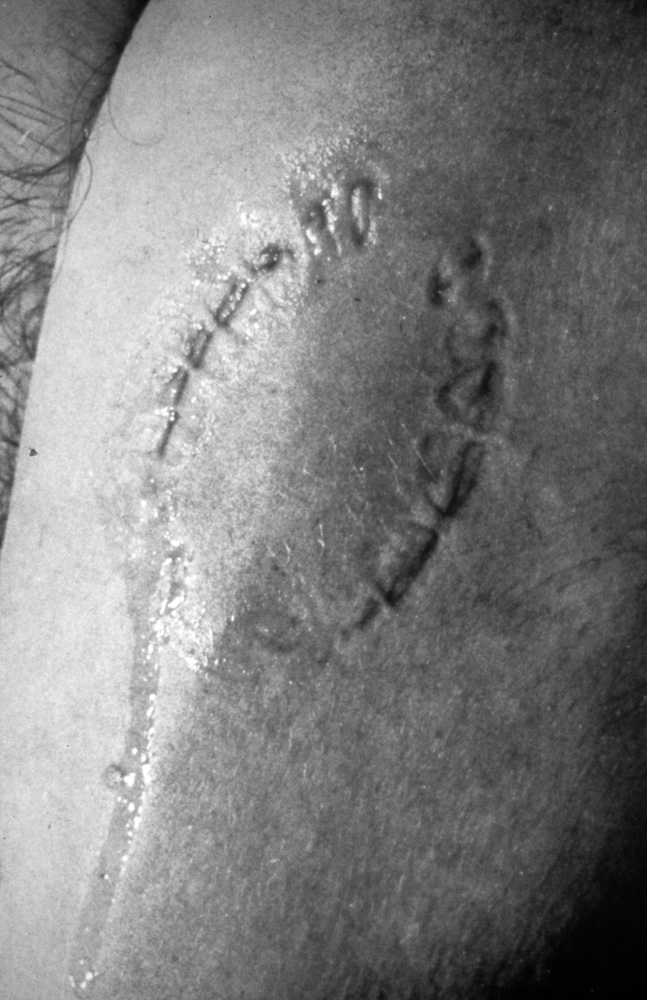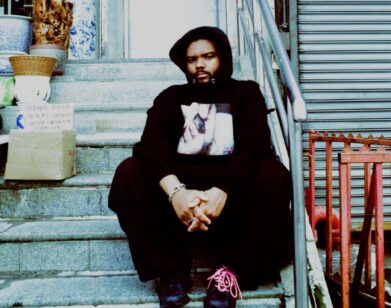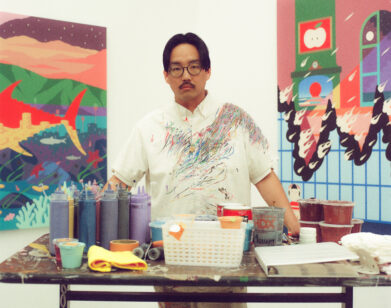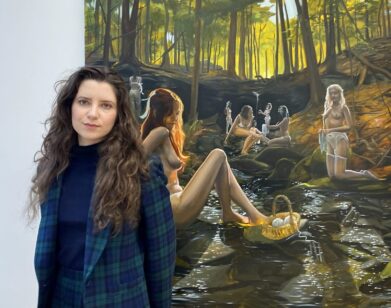Vito Acconci
Vito Acconci’s studio is in a large building in the Dumbo section of Brooklyn. The day I arrived tointerview him, the electronic interactive screen displaying studio numbers wasn’t working, prompting me to ask several people if they knew where theAcconci studio was. No one did. Eventually I found the place where the 69-year-old artist works on his design and architecture projects that range from giant bras to bridges for hedgehogs. The studio is bright, with large windows facing the street. The dominant furnishings are the shelves of books acting as room dividers, each containing a tantalizing selection of titles ranging from psychology and art to song lyrics. Acconci is most famous for his performance installations in the 1970s, which live on for a new generation in documentary footage immortalized on various online sites—especially his most infamous work, Seedbed, in which he lay masturbating under a wooden structure while visitors walked above him at Sonnabend’s soho Gallery in 1972. But while Acconci shed his rebel artist skin years ago, he’s still pushing boundaries.
KAREN WRIGHT: I know you were born in 1940. Tell me a bit about your parents.
VITO ACCONCI: I come from an Italian family. My mother was born in New York, but my father was born in Italy. My father was a very formative person in my life. He hardly ever went to school. I doubt if he even finished a year of high school, but he was totally involved. The only things that were important to my father were literature, music, art, and architecture. He was a bathrobe manufacturer and that was a very money-losing business. As a kid I learned notions of art and notions of not having any money.

WRIGHT: So you learned about failure early?
ACCONCI: Yeah, from my father. The great thing about my father is that it wasn’t about study. It was about loving something. Coming from Italy, he read Dante to me, but he also read me Cole Porter and [William] Faulkner. He became entranced with the English language. He loved puns. He would say things like, “What’s honeymoon salad?” And the answer is, “Lettuce alone.” And he would follow that up by saying, “Don’t look now, mayonnaise is dressing.”
WRIGHT: So you felt privileged, in a way?
ACCONCI: It was an incredible way to grow up, because words that you’re taught—these definite things—you realize they sort of beautifully fall apart; that words are tenuous. In the middle of a large word, there’s a small word that possibly contradicts the larger word. So I grew up where, on the one hand, the only thing I would ever think of doing was something in writing, music, or art, and on the other hand, I could’ve reacted strongly against it because it would’ve been a way to rebel.
WRIGHT: New York became a kind of laboratory for you as well, didn’t it? I’ve heard you say that the Guggenheim was important to you.
ACCONCI: I went to high school four blocks away.
WRIGHT: I feel like the Guggenheim is like a sculpture, and inside it, are objects . . .
ACCONCI: Yeah, but does it have to be sculpture? I mean, sculpture is something you don’t go inside of. Isn’t it more like a wooze space?
WRIGHT: A what space?
ACCONCI: A wooze space, a swoon space. The great thing about the Guggenheim is that you can see art in the fastest way if you want to. Which isn’t bad. [laughs] It’s almost like Frank Lloyd Wright didn’t know something called the Internet was going to exist, so he made it so you can go down as fast as possible.
WRIGHT: You went to school near the Guggenheim?
ACCONCI: I went to a Catholic school in Manhattan. There are some great Jesuits. Most of them drank themselves to death. [laughs] But Jesuits were always a little bit the rebellious Catholics. They could be ultra, ultra, ultraconservative, but then there were priests who said, “I don’t know if I believe.” I went to Catholic school until I was 22 years old. I went to College of the Holy Cross in Worcester, Massachusetts.
WRIGHT: Studying what?
ACCONCI: Writing, but a lot of classics, a lot of Greek and Latin. I then went to the University of Iowa, because Iowa was probably the first school in the United States that had something called a writers’ workshop. I was still writing when I came back to New York, but then I thought, I don’t know if there’s time for novelists here. There’s time for one-page things. A really important influence for me in writing at that time was the work of Jasper Johns. He kind of taught me conventions. The way I saw Johns was as a person who really wanted to use little abstract expressions as his brushstrokes. But he probably thought, “There are a million people doing abstract expressionism as brushstrokes. How do I catch the viewer’s attention?” A painting, like a poem, has to advertise itself in a way. The way Johns did it, it seems like he thought, If I put a number five, a target, letters—if there’s something that everybody knows—then maybe this draws the person in. Then you can do all those abstract expressions as brushstrokes.
WRIGHT: So when you came back from Iowa, you were looking at art?
ACCONCI: I went to every art gallery I could. At that time it was mostly Madison Avenue or 57th Street. Nobody told me which galleries I should actually go to, so I would go to Castelli and Zabriskie as if they were the same thing. But it’s not so bad because it was the only time in my life that I could really find things out for myself. After that, once you start reading about stuff . . . I don’t have to go here. [laughs]
WRIGHT: Tell me about your magazine 0 TO 9.
ACCONCI: The magazine had a relatively short existence, from 1967 to 1969. It was done with another poet who is now relatively well-known, Bernadette Mayer. It was a very small edition, mimeographed and even Xeroxed.
WRIGHT: The name comes from Jasper Johns?
ACCONCI: We wanted it so much not to. Even though I took a lot from Johns, I just didn’t want to name a magazine after him. I tried to make myself believe our name 0 TO 9 was different than the name of his series 0 through 9, but, of course, for anyone who saw it, it was the same. We wanted the name 0 TO 9 because it covered everything.
WRIGHT: You were writing and looking at art. Was this an exciting time?
ACCONCI: I was terrified. I always thought, I can’t waste time, I have to do work. I also thought that I was slower than other people, that I had to concentrate more. I always thought, I’m not brilliant, I have to work. That was something I embedded in myself very early: I have to go home and write. But did I get any more work done than people like Frank O’Hara, who were always going to parties? Probably not.
WRIGHT: Is this the Jesuit training?
ACCONCI: The kind of hair-shirt mentality. In 1968, the common language was finding oneself. This was the time of person-to-person interaction. It was a time of books with titles like Conduct Your Own Awareness Sessions. There was a sociologist named Erving Goffman who was very important to me at that time. He taught at the University of Pennsylvania and wrote Behavior in Public Places. Then there was a sociologist named Edward T. Hall who had these two beautiful books, The Silent Language and The Hidden Dimension, that talked about social distance. Like when people are 10 feet away, each person can see the other person’s whole person. But when those same two people are now two or three inches away, suddenly sight isn’t so important—everything blurs. It made me think about vision being about control. Maybe there are ways to be out of control . . .
WRIGHT: How did you go from writing to doing performance?
ACCONCI: It was time when a lot of us were thinking poetry confined to a page wasn’t enough anymore—that we needed to go into action. Around 1970 and ’71, there was also this presence of little art magazines like Avalanche, ArTitudes, and Interfunktionen.
Dennis Oppenheim was a close friend of mine back then, and I knew Dan Graham and Bruce Nauman’s work. But it was from those little magazines where you’d think, Wow, someone in San Francisco or Holland is doing work like this, too. Maybe there’s a possibility you aren’t crazy.
WRIGHT: Your early work was very transgressive.
ACCONCI: I don’t know if I thought of it as transgressive. Transgression is a word other people have applied.
WRIGHT: How would you describe it?
ACCONCI: In a time when everybody is talking about finding oneself, how do you find yourself? I wanted to do it as literally as possible. How do I prove that I’m concentrating on myself? I prove it by doing something physical. I can bite myself. I can burn the hair off my chest. The goal? Yes, I have a body. I have this thing that people call the self. Maybe I can change the self. [laughs] Maybe I can pull at my breast in a kind of futile attempt to develop a woman’s breast. It’s not that simple to become a woman. But I think what was important, when I think back on that work, is something like The Little Engine That Could. It’s me saying, I think I can, I think I can. Though I’m doing something I obviously can’t, it’s the process toward it that is important. The will toward it, the effort . . . My work was about getting to a place that you couldn’t get to. I also wanted to make myself vulnerable.
WRIGHT: You’ve said in the past that feminist work was very influential for you. But some of your early work, like Theme Song [a 1973 black-and-white video in which Acconci gives a close-up monologue to the camera], seems to me to be attacking feminism.
ACCONCI: I don’t know if it was. I don’t know if my work would have been heard if it weren’t for that early feminist writing. It was very influential to me. I started to feel embarrassed about being male, and it led me to make work where I could allow myself to be vulnerable.
WRIGHT: Videos of a lot of those early works are currently on YouTube. People react as if you made them yesterday.
ACCONCI: I know.
WRIGHT: I find that so weird.
ACCONCI: What’s interesting to me is that some people seem to be affected by these things as if I did do them yesterday. That puzzles me because I thought they were so much out of that time.
WRIGHT: I think people are reacting to the intensity.
ACCONCI: I mean, obviously, I’m kind of grateful for that. For some reason, younger people continue to feel like there’s something to get here.
WRIGHT: And you were affected by things other than just the self-help craze. There was also the Vietnam craziness.
ACCONCI: The Vietnam War was probably the most important thing, but did I ever make a piece particularly about Vietnam? I didn’t think I had to. Why was I biting myself? Why was I in a basement saying, “I’m alone here,” wielding a lead pipe and crowbars? It was like I was doing the Vietnam War. [laughs] It was like I was being America. If I put a blindfold on, I can’t see you as people, which seemed to be what the United States was doing. I mean, it was important for people in my generation, because I grew up in the ’40s, at a time when America was supposedly the hero nation. America saved Europe. And, some years later, we realized, America is a criminal.
WRIGHT: The work seems to follow the model of conceptual work for that time—being governed by a set of rules or instructions.
ACCONCI: I don’t know if any of these words are quite right, but you give yourself a set of rules, a set of regulations to follow. You hope it’s an open system and that the rules don’t restrict you—but I guess you do want some kind of restriction.
WRIGHT: You make it hard on yourself—being blindfolded or constrained in some way.
ACCONCI: Although many of those things did have a kind of practical reason. If I’m going to be in a basement telling people not to come down, or if I’m going to have crowbars and lead pipes in my hands, I’m going to have to blindfold myself. If I see them as people, I can’t do anything. I’m not going to hit a person, but I can hit an abstraction.
WRIGHT: Tell me about Seedbed.
ACCONCI: Seedbed had nothing to do with masturbation when it began. My work never began with subject matter. Seedbed had to do with putting myself in a position where I wouldn’t be a central point in the space. I would blend with the space. I would be part of the architecture of the room. I wanted to be part of the floor. Then I thought, Okay, I’m under this floor. What do I do? I can potentially be under every person that comes into this gallery. I can move around. At first I thought, Okay, I have to be doing something down there, and something has to connect me to the people. How do people even know I’m there? At first I had this illusion that I could go into the space in Castelli’s ceiling, but of course I couldn’t. SoHo galleries had very low ceilings, so I had to build a ramp. And I thought, Maybe something should go from inside me out. Maybe I can spit. [laughs]
WRIGHT: Was the gallery worried about the content at all?
ACCONCI: Sonnabend had just moved to soho. Nobody knew soho. They needed attention much more than they needed sales.
WRIGHT: Everyone came to see that performance. But then you decided to move away from performance in your work.
ACCONCI: I didn’t want to admit that I was a performer. A performer meant spotlights—a performer had connotations of theater. I would have preferred agent to performer. I started to think that my work was getting out of date. I thought it was still caught up in the language of the ’60s, still caught up in the notion of finding the self. But it wasn’t the ’60s anymore. A lot of other people were having very different notionsof person, thinking that self only existed as part ofa social system, a political system, a cultural system. So I wanted my stuff to be part of that system. I probably got so used to using myselfthat I didn’t know how to totally get rid of myself. So I left some kind of vestige of myself. These things started to be called installations.
WRIGHT: How did you make the leap from art to design and architecture?
ACCONCI: What I never wanted in art—and why I probably didn’t belong in art—was that I never wanted viewers. I think the basic condition of art is the viewer: The viewer is here, the art is there. So the viewer is in a position of desire and frustration. There were those Do Not Touch signs in a museum that are saying that the art is more expensive than the people. But I wanted users and a habitat. I don’t know if I would have used those words then, but I wanted inhabitants, participants. I wanted an interaction. So I resorted to using the body. Not necessarily my body, but Iresorted to the body of visitors in the gallery.
I started to make instrumental vehicles that people could use. They make some kind of shelter—some kind of architecture. From 1980 to 1983, all the pieces, like Instant House, consisted of some kind of instrumental vehicle that could be used by the visitor in the gallery . . . You sit in a swing, you ride a bicycle, and now you make a space. In my career, it was a space that made images. Then there was the early ’80s, kind of Metro Pictures time. People were talking about pictures a lot, and I was never particularly drawn to images. But I thought, You know, if picture is in the air, is there some reason to use picture? So if these pieces were architectural games, the pictures were almost the counters of the games. It made me think of surface some more.
WRIGHT: How did you get from the architectural-games pieces to pure architecture?
ACCONCI: As always, things went from one thing to another because of some disappointment, some lack. I liked the idea of architectural games—you’re always building and rebuilding. And I still thought of myself in opposition. I thought, If architects build a dream house, then I want to build a bad-dream house. My piece was called Bad Dream House.
WRIGHT: Tell me about Graz—the island in the Mur was your biggest architectural project.
ACCONCI: Yes. Curator Robert Punkenhofer suggested to the Graz 2003 committee that there should be a person-made island in the Mur river nearby. The reason he thought that was because his young son still lived in Graz, and he thought that children had no reason to go down to the river. The first year, we went through many proposals. Can we make an island of water? Can we make an island of waves? Can we make an island of whirlpools? Can we make an island of bubbles? We made many early drawings.
WRIGHT: It’s very poetic.
ACCONCI: We always start like that. We got nowhere trying to make an island. The mission was to build a person-made island that had three functions: It would be a theater, a café, and a playground. So eventually we took the idea of a bowl and twisted it upside down to become a dome. If the bowl is the theater, the dome is the café. The twisted space in between becomes the playground. It took a year of false starts to figure that out.
WRIGHT: There has always been a lot of humor in your work and in your outlook in general. I was struck by something you once said: You wished that when you got inside a Richard Serra sculpture, there would be a hot-dog stand. That was one of the great lines of all time.
ACCONCI: If Richard ever read that, I’d probably become inanimate for life.
WRIGHT: Are you going to recant it?
ACCONCI: I can’t. The nice thing about print is you can’t take it back. [laughs] It’s a particular kind of humor, though I think it has absolutely nothing to do with irony. I think it has to do with Marx Brothers humor. [laughs] You know, it has to do with throwing things apart. A woman I knew said that she loved Marx Brothers movies but she always wondered who cleans up afterward. I found that a terrifying thought. [laughs]
WRIGHT: Some of your work also displays a sense of the absurd. I am thinking of the pieces that are giant bras that work as furniture—the wall bras. Can you tell me about those?
ACCONCI: There are seven of them.
WRIGHT: Different cup sizes or always the same?
ACCONCI: No, always the same cup size, but you can put them in different positions. So any museum can change them around. They were meant to be furniture and a light. You sit inside the cup and listen to music.
WRIGHT: What projects are you working on now?
ACCONCI: There’s an interesting one in Indianap-olis. It may be a first attempt at a project that mixes the physical with the virtual. I picked the site specifically because I thought it would give us a chance to do something that we hadn’t approached before. It’s a city street that goes through a building—pedestrians and bicycles and cars all pass through. The passage through the building will be a different color depending on the time of day. Around the bicycle path and the pedestrian sidewalk there’s a mesh system that holds thousands of LED lights. When you go through this tunnel, you activate sensors that set off lights that swarm around you and follow you. Each person sets them off—it’s almost like fireflies, where one person starts to mix with the fireflies of another. It’s one small attempt to make a space that is constantly moving. Then there is a project in Holland, near Eindhoven. It’s on land used for things like camping. They want us to do a bridge that goes over the highway. The subplot is that they are worried about animals’ getting hit by traffic, so they are suggesting we make a bridge for small animals. [laughs] It’s an interesting project, but also kind of an impossible one.
WRIGHT: Your work is so influential.
ACCONCI: That wasn’t a goal. But all through my life, I have been really, really influenced by things. Writers first, but movies and music, too. I always thought, I hope I can do that for somebody else. Not that I wanted people to copy my work. The kind of influence you want is a much deeper influence. It’s like empowerment. Things are like this, but what if they were like that? What happens if you turn everything inside out? It’s something that not just artists do. I think scientists do that, too. There’s a theory: What if we pour water on it? That’s also what a child does. If a child came in now, the child would ignore us, go under the table, and make a house.
Karen Wright is a freelance writer and curator living and working in London.







